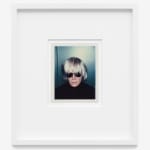Andy Warhol
In this late self‑portrait from 1986, Andy Warhol appears as both artist and apparition. Wearing his signature platinum wig and dark sunglasses, he meets the Polaroid’s flash with an unblinking stare; the background recedes to near‑nothingness, the palette is drained of color. Made barely a year before his death, the photograph belongs to a carefully staged suite of Polaroids that underpinned his last—and now canonical—series of self‑portraits, works that crystallize Warhol’s final public image.
Throughout the 1970s and 1980s Warhol relied on Polaroids to net the faces of celebrities, friends, and strangers. Those instant prints served as both diary and working template for silkscreen canvases. Here, however, the camera turns on its operator. The medium’s trademark immediacy heightens the tension between authenticity and performance—between the man and the mask patiently constructed over decades of celebrity.
What arrests the eye is the portrait’s deliberate flatness. Emotion is withheld; the effect is ghostly. The wig crackles like live wire, while the black turtleneck effaces the body, leaving only a disembodied head adrift in shadow. The sunglasses seal off any reciprocal gaze, rendering the image a perfect surface of stylized detachment. Yet within that surface resides an unexpected confession: absence as a final form of self‑revelation.
The picture also inserts Warhol into a venerable lineage of self‑portraiture. From Dürer and Rembrandt to Goya and Picasso, artists have confronted the mirror in moments of peril, doubt, or reckoning. Warhol’s “Fright Wig” images acknowledge that tradition but refract it through Pop’s neon glare and postmodern skepticism. Instead of laying himself bare, he stages the disappearance of the self, turning the photograph into both elegy and icon. Today the “Fright Wig” Polaroids rank among the most indelible images in Warhol’s oeuvre—bleached of color and context, yet saturated with meaning.
Public institutions now steward a constellation of these irreplaceable frames. In the United States, the Museum of Contemporary Art, Los Angeles, and the National Gallery of Art, Washington, D.C., each hold singular prints revealing subtle shifts of pose and flash fall‑off. The Andy Warhol Museum in Pittsburgh safeguards the most comprehensive cache from the session, while Chicago’s Museum of Contemporary Photography preserves another rare variant. Across the Atlantic, photographs once catalogued in Edinburgh are now displayed under Tate’s ARTIST ROOMS programme in London. Together, these holdings plot Warhol’s last act of self‑myth-making across a global network of museums—each print a solitary, flickering frame from his final performance.
NOTES
Initialed 'T.J.H.' by Timothy J. Hunt of The Andy Warhol Foundation in pencil and 'Estate of Andy Warhol,' 'Andy Warhol Foundation for the Visual Arts' stamps on the verso. It also presents the inventory number of the Andy Warhol Foundation written in pencil.
Provenance
The Estate of Andy Warhol, New YorkThe Andy Warhol Foundation for the Visual Arts, New York
Private collection, United States
Private collection, New York




